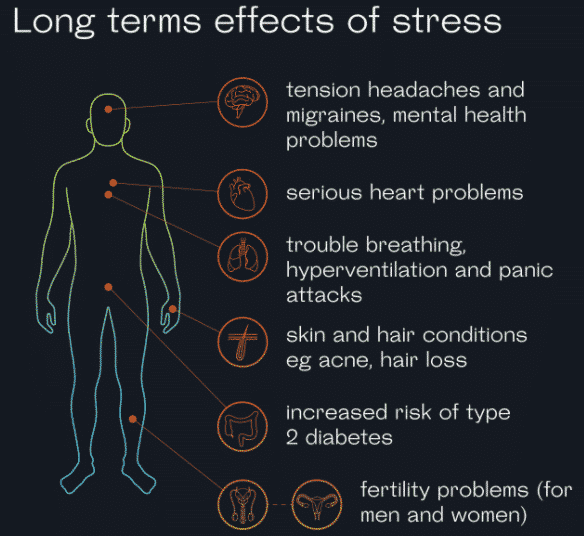If I make a random glance into your everyday life at any moment of time, there is a big chance that you’re currently experiencing stress. That’s like a literal feature of contemporary life – though this is rather sad since stress was not initially designed by the great hand of evolution to act this way.
According to the definition from the National Library of Medicine, “stress” is an umbrella term representing experiences in which the environmental demands of a situation outweigh the individual’s perceived psychological and physiological ability to cope with it effectively. To put it simpler – what makes us stressed are any external influences (‘stressors’) of extraordinary power, and it works both ways. Therefore, before knowing how to measure stress, it is advisable to identify stress etiology and type to measure stress levels all nice and proper – with the help of a corresponding stress app!
Considering the overwhelming prevalence of chronic, harmful stress (the positive answer to the “who is affected by stress” covers most of the population, perhaps only excluding the very youth and elderly), it’s a relevant problem of modernity and needs to be solved. Yet, those who hold authority can only fix the problem with massive infrastructure projects and a push for some unspoken global reforms. It is, honestly, not yet feasible – in both rational and economic ways; consequently, an individual should take the matter of managing stress into its own hands.
What does stress level mean?
Before objectively measuring stress level with all due accuracy and precision using stress management app – https://www.webmd.com/balance/stress-management/stress-level-too-high, you may actually try to assess your stress level meaning subjectively, taking into account the way different stress levels influence your body and mental status.
Low-stress level
Low-stress levels can be divided into two subgroups by etiology. The first variant of low stress implies the lack of mental “stress” – the mental condition called apathy, which makes the individual utterly indifferent to anything from the outside world. The second variant involves the decreased bodily reactions in response to stress-inducing factors, which is essentially a hyperergy of the autonomic nervous system.

Significantly enough, both of these issues can be signs of severe underlying disorders. Accordingly, if you experience something like this, take your time to visit a physician of the corresponding specialty as soon as possible.
High-stress level
Stress levels too high result, first and foremost, in increased heart and breath rates. Additionally, you may feel other vegetative symptoms like profuse cold sweating – or anhidrosis. Stress will reduce your desire to eat, drink and experience happiness in any other way – instead, and you will crave safety and blissful quietness.
Even though acute stress makes your body more resilient for a short moment of time. The chronic maintained high-stress level makes your immune system weaker due to the depletion of available reserve resources, therefore making your body way more susceptible to illnesses and neoplasms in the long term.
Ideal stress level?
To be fair, “ideal stress level” is kind of an oxymoron, since how could there be an ideal level of negative, harmful state? As such, I find the concept of “average stress level” to be more suitable. Anyways, the average stress level you should experience presupposes that you are not stressed at all in your daily life yet can react with stress necessary in truly dangerous and threatening situations.

How to measure stress levels
Though you can subjectively define the overall scale of your stress levels, all the convenient objective ways to measure stress – https://www.stressresilientmind.co.uk/articles/how-to-measure-stress – include some kind of health app and fitness tracker.
Fitness trackers
I presume you wonder – how does a smartwatch measure stress? Well, fitness trackers are essentially hardware tools whose job is to gather your vital data to be analyzed later. So they are, in their way, irreplaceable.
Fitness trackers come in great variety, ranging from casual fitness wristwatches collecting info using the technology of photoplethysmography to specialized athletic chest-strapped trackers detecting a change in electromagnetic fields, like your doctor’s electrocardiograph.
Their efficiency and accuracy are directly proportionately related to their cost, though. So choose what’s best for you considering your financial ability, since, either way, even the budget device will provide you with a reasonable quality of data.
What should be mentioned is the capability of using your smartphone (exactly – its camera) to record your heartbeats. Yeah, it isn’t exactly accurate, especially if your phone lacks in-camera image quality. Nonetheless, it is a lovely quirky feature that allows you to get acquainted with the technology before investing any money. So, use it as a convenient proof-of-concept.
Health apps
The health apps provide you with the brainy part of the operation. First, it does all the statistical calculations in order to present you with some clean stress charts. Additionally, after a particular observation time, health advice can be given analyzing your stress values.
Such apps are also offered in abundance in the app stores, and it can be challenging for some users to choose. The best solution is not to hesitate to select for too long and just go with your feeling, trying the most popular and most user-friendly apps on the catalog, like, for example, Welltory.
Heart rate variability and stress
For analyzing your stress, the apps require Heart Rate Variability data. Heart Rate Variability is a metric extracted from your usual heart rate and means the variance in heartbeat intervals. Take this into notice – even if you have 60 beats per minute heart rate, this does not mean that there is an exact 1 second between every beat – and this is precisely what heart rate variability tracks.
The rule of thumb for heart rate variability is as follows: high HRV means low stress and vice versa. Why is this so? Well, in relaxed, stress-free environments, your heart beats slowly and without excessive control from the autonomic nervous system, and heart automation is mainly done by its pacemaker cells.
But, on the other hand, when stress arises, your nervous systems send signals that make the heart beat faster, decreasing intervals and their variability – after all, in dangerous situations, every heartbeat can be crucial to survival. So there is no place for ‘variability’ at all.





